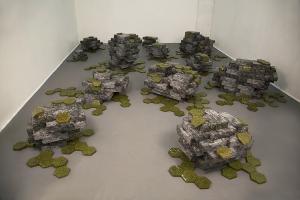Collective Monument
January 25, 2017

Onejoon, Nara Park and the DZT Collective investigate the global politics and aesthetics of monuments in the STAMP gallery.
\r\n College Park, MD— "Collective Monument" presents works by three contemporary artists spanning three continents, all of whom investigate the concept of monumentality as a complex and suggestive cultural form. The exhibition elaborates the nuanced, transnational networks of power, memory and participation that emerge from monuments as objects and as collaborative projects. It invites audiences to consider monuments as artworks that propose new forms of collective action and paradigms of belonging. The exhibition calls on viewers to question how monuments reflect conditions of global interconnectedness and speak in dialogue with diverse audiences today. "Collective Monument" is on view at the Stamp Gallery at the University of Maryland, College Park, January 25 through March 11, 2017.\r\n
\r\n\r\n South Korean artist Onejoon Che’s three-channel video installation "Mansudae Master Class" (2015) draws attention to one of the most curious aspects of the legacy of Cold War cultural diplomacy: overseas projects created across Africa by the North Korean state’s Mansudae Art Studio as part of the nation’s attempts to sustain and rekindle political alliances established in the 1960s and ‘70s. The resulting monuments, made in the Socialist Realist style, have been subject to critical scrutiny in the various nations in which they are realized. However, they also testify to the power of monumental commissions to transcend isolationist politics as states and their leaders continue to promote monuments as a vital art form.\r\n
\r\n\r\n Washington, DC-based sculptor Nara Park’s "Never Forget" (2014) grew out of the artist’s fascination with the monumental paradigm of packaged goods displayed in bulk, a phenomenon she has observed across the globe. Her work places this consumer aesthetic in dialogue with words borrowed from inscriptions on monuments around the United States’ capital city. Park’s artwork takes on new significance in the current American political situation as the content of values often considered "shared" are both contested and deconstructed. "Never Forget" connects the tropes of monumental form with disposable commodities and the perpetual fluctuations of language, challenging perceptions of the monument as a stable and enduring object. \r\n
\r\n\r\n While the works by Onejoon Che and Nara Park critically examine the monument at the nexus of national political ideology and transnational modes of consumption, the DZT Collective—an artistic, curatorial, and architectural collective operating between Italy and Albania—stages an opportunity for visitors themselves to create a monument. Their interactive installation "Study for a Monument" (2014–ongoing) prompts individuals and groups to use their own bodies to speak to and about the power structures that frame social reality today. The work asks the viewer: to whom might you construct a monument and how might you embody the ideals you wish to see reflected therein? \r\n
\r\n\r\n "Collective Monument" culminates with a symposium on the topic of monumentality in art across time and geographies. A keynote lecture by New York-based artist Lisi Raskin opens the event on March 10, 2017 at the Adele H. Stamp Student Union and is free and open to the public. \r\n
\r\n\r\n ABOUT THE ARTISTS\r\n
\r\n\r\n Onejoon Che uses photography and video to investigate the sociopolitical transformations taking place in contemporary Korea. His work is informed both by his study as a commercial photographer and by his time in the South Korean military, and many of his artworks reflect on the effects of the military regime through film and archival interventions. Che has participated in a number of exhibitions throughout the world, such as the Taipei Biennale, Palais de Tokyo Module, the New Museum Triennial and the Korean Pavilion at the Venice Architecture Biennale. \r\n
\r\n\r\n Nara Park considers simulations of nature as expressions of the human desire for immortality. Her interest in these themes derives from her observation of confluences in Eastern and Western affluent contemporary culture in the cycle of industrialization and technological development. She grew up in the industrial city of Seoul, South Korea, where technology and manufacturing compensate for a shortage of natural resources and synthetic materials are more accessible and useful than natural materials. Park’s work aims to generate life from artificial materials, exploring our desire to imitate nature. Her art also considers the paradox of a consumer culture that simultaneously desires permanent ideals and ephemeral objects. http://naraparkstudio.com. \r\n
\r\n\r\n DZT (DyZeroTre) Collective is an artistic and architectural collective operating between Italy and Albania. The core of the group comprises artist and curator Stefano Romano, architect and planner Eri Çobo and artist Martina Dierico. A fourth member, artist and musician Guido Affini, contributes to the group through ARIA, an electro-acoustic music project that combines different languages. DZT works processually through aesthetic acts that do not attempt to transcend conflicting viewpoints, new antagonisms or the urgency of social reality. Through performances, video, installations, photography and drawings, DZT aims to create non-aligned images of our contemporary reality. http://www.dyzerotre.info. \r\n
\r\n\r\n ABOUT THE STAMP GALLERY\r\n
\r\n\r\n Located on the first floor of the Adele H. Stamp Student Union—Center for Campus Life at the University of Maryland, College Park, the Stamp Gallery is dedicated to exhibiting contemporary art, especially the work of emerging and mid-career artists. The Stamp Gallery supports contemporary art that is challenging, academically engaging, and attuned to broad community and social issues. Through meaningful exhibitions and programming, the Gallery offers outside-of-the-classroom experiential learning opportunities. It functions as a laboratory where emerging artists and curators experiment and work through their ideas. The Gallery’s programming aims to emphasize the importance of process to contemporary artistic practice and to provide a forum for dialogue.\r\n
\r\n\r\n FREE and open to the public: Mondays–Thursdays: 10 am–8 pm; Fridays: 10 am–6 pm; Saturdays: 11 am–5 pm; Sundays: Closed. More information: thestamp.umd.edu/gallery\r\n
\r\n\r\n Image credit: The STAMP Gallery. Nara Park, "Never Forget," 2014. Plastic packaging bozes and vinyl. Courtesy of Hamiltonian Gallery and Artists. Gift of the artist via Nara Park. \r\n
\r\n\r\n \r\n
\r\n\r\n \r\n
\r\n\r\n \r\n
\r\n
